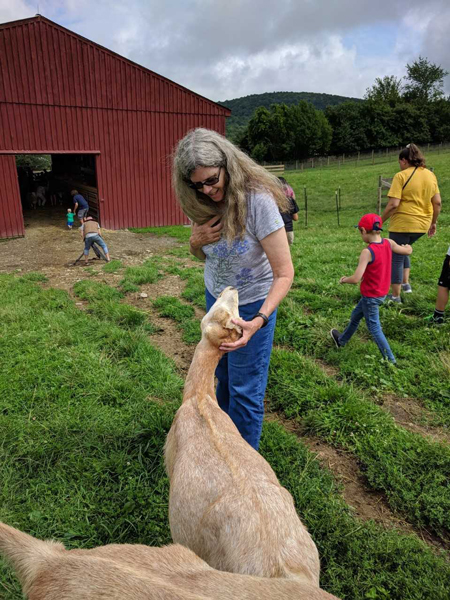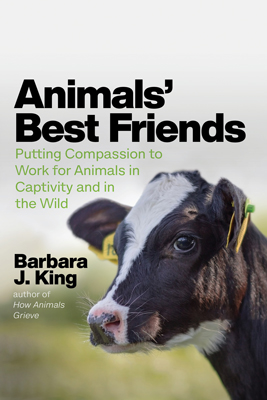Bettering the Lives of Animals
By Flora Taylor
Barbara J. King, an expert on animal cognition and emotion, suggests steps we can take to begin living more harmoniously with our fellow creatures.
June 12, 2021
Science Culture Ethics Policy Animal Behavior Review
ANIMALS’ BEST FRIENDS: Putting Compassion to Work for Animals in Captivity and in the Wild. Barbara J. King. 274 pp. University of Chicago Press, 2021. $25.
In Animals’ Best Friends: Putting Compassion to Work for Animals in Captivity and in the Wild, anthropologist Barbara J. King invites us to consider a myriad of actions, large and small, that we can take to become better allies to animals. She understands that learning about the many ways in which animals could benefit from our compassionate action can be overwhelming. Helping them is a Sisyphean task, and hearing about their suffering can be painful, or even heartbreaking. King doesn’t want us “to end up in an emotional landscape of anxiety or severe depression,” so she emphasizes that making things better for animals even in small ways can enrich our lives and lift our spirits.
King believes that people learn best from stories, and she tells them well. She has borrowed some vivid ones from other authors, but most of her stories draw on the personal experiences through which her own understanding of animals has deepened over the years as she has confronted one moral dilemma after another and found personal solutions for them. We come away with a cumulative sense of having accompanied her on a Bildungsroman—a journey of psychological and moral growth.

From Animals’ Best Friends: Putting Compassion to Work for Animals in Captivity and in the Wild
King knows that some topics are more difficult to stomach than others, so she doesn’t start out by talking about animals on our plates; that chapter is preceded by ones that deal with animals at home (ants, spiders, pets), animals in the wild (orcas, bees, frogs, beavers, wolves, deer), and animals in zoos, and it’s followed by a final chapter about animals in research labs. Animals in the home and in the wild are much greater in number than zoo animals, and their suffering is intertwined with a greater number of complex policy issues and trade-offs. Zoos are a more compact topic, one that King zeros in on and digs into, and the result is a chapter that is more comprehensive and less scattershot than the ones that preceded it. And I think I found the zoo chapter easier to take in than the earlier ones, because it offered me fewer occasions for self-reproach: I’ve never personally owned or operated a zoo, but I have owned pets and cared for them imperfectly; murdered harmless spiders; trapped rabbits; and looked on while family members gigged frogs and shot small birds.
The chapter about animals as food begins with the observation that the animal agriculture industry is a major contributor to greenhouse gas emissions. One of the most effective actions we can take to combat climate change is to consume less meat and dairy, and King believes that changing what food we eat “is the single biggest opportunity we have to help animals.” In keeping with the book’s overall approach, she takes a reducetarian perspective: People needn’t switch immediately to a diet based exclusively on plants—just cutting back on meat, seafood, and dairy consumption can be helpful. And King provides stories about the behavior and inner lives of animals that “invite us to think before we eat.”
I’ve thought a lot about meat-eating ever since the day at age 5 when I proposed to my parents that we plant hot dogs in our garden (only to find out, to my horror, what actually has to be done to create a hot dog). But I had never given much thought to the well-being of dairy cattle. King notes that they are separated from their calves only days after giving birth and describes how physically debilitated they are by forced dairy production; they are worn-out wrecks by the time they end up being sold to slaughterhouses at 5 or 6 years of age. To give us a sense of what these cows have been deprived of, King tells a story about dairy cattle at a farm in England where calves are allowed to remain with their mothers for as long as they choose. When those calves have become adult cows living elsewhere on the farm, they still sometimes seek out their mothers for comforting when they experience something traumatic. One cow, who had required veterinary care for her womb after giving birth to a stillborn calf, traveled across three fields to find her mother and spent six days being consoled by her before returning to her regular routines.

From Animals’ Best Friends: Putting Compassion to Work for Animals in Captivity and in the Wild
In the chapter on lab animals, which focuses mainly on the use of animals in biomedical research, King emphasizes that protections for these animals are very weak, even in federally regulated and federally funded facilities, including universities. The Institutional Animal Care and Use Committees created for their protection by the U.S. Congress and the Public Health Service are “stacked against the animals’ interests,” she says. The IACUCs are not required to consider ethical questions when deciding whether to approve a research proposal. They use a majority voting system, and two-thirds of the members of IACUCs at top institutions are themselves animal researchers, which means that they are at risk for conflicts of interest: They are stakeholders in the system and may have a financial interest in maintaining the status quo; in addition, they are voting on the research proposals of their colleagues at the institution, some of whom they may work with closely. One analysis found that 98 percent of in-house research proposals were approved by IACUCs, even though 61 percent of those same proposals were found wanting when they were anonymized before being critiqued by reviewers from other institutions.
King maintains that animal experiments are often poorly designed: She cites a survey of 271 animal studies in the United Kingdom between 1999 and 2005, which found that only 12 percent were randomized, and in only 14 percent of the studies using qualitative scoring were the people doing the scoring “blinded” (unaware of the group to which the animal being evaluated had been assigned). In addition, she notes that the efficacy of using animal models for human disease is not great: The animals often turn out to be poor surrogates for humans who have the disease, and even findings that seem promising often fail to translate into treatments beneficial to humans. Also, substitutes for animal models are increasingly available.
At the insistence of biomedical industry lobbyists, the U.S. Animal Welfare Act does not cover rats, mice, and birds bred for research. And recently labs have begun to experiment on cephalopods (octopuses, cuttlefish, and squid), because the United States provides no protection from experimentation for invertebrates. King would like to see guidelines in place for animal research that use the same principles as those of the Belmont Report (which aims to protect human subjects), and she belongs to a working group that hopes to accomplish that. She deplores failures to be transparent on the part of those conducting biomedical research on animals.
The lives of animals seen and unseen are affected by the choices we make. We have a responsibility to them because we have exploited them for millennia, and simply because they are vulnerable. So we must ask ourselves: What might we be doing otherwise?
King offers a variety of suggestions in keeping with her credo that it’s fine to start small—you could, for instance, cultivate plants that attract and support pollinators, adopt a few rescue rats that are retiring from a research lab (or donate blankets for the ones someone else is adopting), donate money to an animal sanctuary, help curb the population of feral cats by getting involved in a local “trap, neuter, and release” program, or visit your local zoo regularly and contact management when you notice areas where improvements might be needed.
Bearing witness, King says, is the least we can do to honor the animals who suffer as a result of human actions.
American Scientist Comments and Discussion
To discuss our articles or comment on them, please share them and tag American Scientist on social media platforms. Here are links to our profiles on Twitter, Facebook, and LinkedIn.
If we re-share your post, we will moderate comments/discussion following our comments policy.